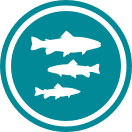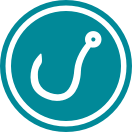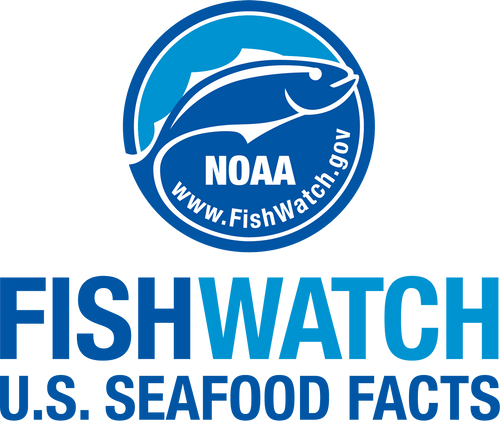Ocean Quahog
 Ocean quahog clams. Credit: NOAA Fisheries/Greater Atlantic Regional Fisheries Office
Ocean quahog clams. Credit: NOAA Fisheries/Greater Atlantic Regional Fisheries Office
Ocean quahog clams. Credit: NOAA Fisheries/Greater Atlantic Regional Fisheries Office
About the Species
 Ocean quahog clams. Credit: NOAA Fisheries/Greater Atlantic Regional Fisheries Office
Ocean quahog clams. Credit: NOAA Fisheries/Greater Atlantic Regional Fisheries Office
Ocean quahog clams. Credit: NOAA Fisheries/Greater Atlantic Regional Fisheries Office
Ocean quahogs are distributed from Newfoundland to Cape Hatteras, NC. The U.S. fishery focuses on two regions: Maine and Long Island, New York. Dredge and hand harvest are authorized in the commercial fishery, with hydraulic clam dredges being the primary gear type used. The recreational fishery is limited to hand harvest. Ocean quahogs are generally processed for human consumption in soups, chowders, and stews; while a small portion of landings are also sold in the bait market. U.S. wild-caught ocean quahog is a smart seafood choice because it is sustainably managed and responsibly harvested under U.S. regulations. Implementing regulations are found at 50 CFR part 648 subpart E.

Population
Above target population level.

Fishing Rate
At recommended level.

Habitat Impact
Fishing gear used to harvest quahogs has minimal impacts on habitat.

Bycatch
Fishing gear used to harvest quahogs is designed to minimize bycatch.
Population Status
- According to the 2020 stock assessment the ocean quahog stock is not overfished and is not subject to overfishing. Summary stock assessment information can be found on Stock SMART.
- Ocean quahogs are relatively unproductive and can only support low levels of fishing.
- Population levels are declining despite relatively low fishing rates, but remain above target levels.
Appearance
- Ocean quahogs are bivalve mollusks—they have two hinged shells that enclose their body.
- Shells are thick and oval-shaped.
- Outside is a dull gray with growth rings that can be used to determine its age.
- Interior is white with a purple border.
- Most quahogs in U.S. waters are 2.8 to 4.3 inches in shell length.
Biology
- Ocean quahogs spawn by releasing eggs and sperm into the water column where the eggs are fertilized.
- Larvae drift with the currents for at least 30 days until they develop into juveniles and settle to the bottom.
- Ocean quahogs spawn once a year, either in the summer or fall. The spawning season is sometimes extended over a number of months as quahogs release eggs and sperm a little at a time.
- Ocean quahogs are among the longest-lived marine organisms in the world. Off the U.S. East Coast, where the fishery takes place, ocean quahogs can live for at least 200 years.
- They grow very slowly and do not start to reproduce until around age 6, and do not reach a commercially harvestable size until about age 20.
- Ocean quahogs are filter feeders. They bury themselves in the ocean floor and pump oxygen-filled water and food particles in through their siphons, which extend above the surface of the ocean floor.
- They feed on microscopic algae.
- Many animals prey on juvenile ocean quahogs, including invertebrates such as rock crabs, sea stars, and other crustaceans, and fish such as longhorn sculpin, ocean pout, haddock, and cod.
- Once ocean quahogs have reached a certain size, they have a very low predation rate. They burrow in the sandy ocean floor and their thick shells close completely, providing substantial protection from potential predators.
Where They Live
Range
- Ocean quahogs are found in the western Atlantic as far south as Cape Hatteras, North Carolina.
Habitat
- Ocean quahogs live in water between 25 and 1,300 feet deep.
- In the northern part of their range, they’re found in shallower water closer to shore.
- The U.S. stock is almost entirely within federal waters (3 to 200 nautical miles from shore), except for a modest amount off the coast of Maine and in waters between 65 and 260 feet deep.
- Ocean quahogs are rarely found where bottom water temperatures exceed 60˚ F.
- Eggs and larvae are found in the water column and drift with the currents until they develop into juveniles and settle to the bottom.
- Ocean quahogs burrow in a variety of sediments, especially fine sand.
Fishery Management
- NOAA Fisheries, the Mid-Atlantic Fishery Management Council, and state resource management agencies manage the ocean quahog fishery.
- Managed under the Surfclam-Ocean Quahog Fishery Management Plan:
- Fishermen must have a permit for commercial harvest ocean quahogs.
- Individual transferable quota (catch shares) program—managers set an annual catch limit for federal waters and allocate it among individual fishermen or vessel owners. These individual quotas can be sold or leased.
- Closed areas due to environmental degradation or to toxins that cause paralytic shellfish poisoning (PSP).
- Fishermen harvesting ocean quahogs from Georges Bank have additional requirements under the PSP testing protocol.
- Mandatory vessel monitoring systems.
- Fishermen must maintain and submit logbooks of each fishing trip to document catch.
- The ocean quahog fishery off Maine is managed separately because of differences in biological, fishery, and market characteristics.
- The portion of this fishery in federal waters off the Maine coast is managed under a relatively small catch limit that is separate from the catch limit used to manage the rest of the quahog fishery (described above).
- To participate in this fishery, vessels must have a separate limited access federal permit, use a mandatory vessel monitoring system, and maintain and submit logbooks of each fishing trip.
- State authorities manage the portion of this fishery in Maine state waters.
Harvest
- In 2022, the ocean quahog fishery produced 15 million pounds of meats, valued at $12 million, according to the NOAA Fisheries commercial fishing landings database.
- Commercial fishermen harvest ocean quahogs with hydraulic clam dredges, which use jets of water to dislodge ocean quahogs from the sandy ocean floor.
- A smaller “dry” dredge (without hydraulic jets) is used in Maine waters.
- Ocean quahogs burrow into sandy bottoms on the continental shelf, an environment that is thought to recover quickly after a hydraulic clam dredge passes over it.
- The bars on commercial clam dredges are spaced several inches apart so they do not collect anything but the targeted quahogs.
- The quahog fishery is managed under an individual transferable quota program that slows the pace of the fishery and increases its efficiency, significantly reducing bycatch.
Scientific Classification
- Ocean quahogs are found in the western Atlantic as far south as Cape Hatteras, North Carolina.
- Ocean quahogs live in water between 25 and 1,300 feet deep.
- In the northern part of their range, they’re found in shallower water closer to shore.
- The U.S. stock is almost entirely within federal waters (3 to 200 nautical miles from shore), except for a modest amount off the coast of Maine and in waters between 65 and 260 feet deep.
- Ocean quahogs are rarely found where bottom water temperatures exceed 60˚ F.
- Eggs and larvae are found in the water column and drift with the currents until they develop into juveniles and settle to the bottom.
- Ocean quahogs burrow in a variety of sediments, especially fine sand.
Fishery Management
- NOAA Fisheries, the Mid-Atlantic Fishery Management Council, and state resource management agencies manage the ocean quahog fishery.
- Managed under the Surfclam-Ocean Quahog Fishery Management Plan:
- Fishermen must have a permit for commercial harvest ocean quahogs.
- Individual transferable quota (catch shares) program—managers set an annual catch limit for federal waters and allocate it among individual fishermen or vessel owners. These individual quotas can be sold or leased.
- Closed areas due to environmental degradation or to toxins that cause paralytic shellfish poisoning (PSP).
- Fishermen harvesting ocean quahogs from Georges Bank have additional requirements under the PSP testing protocol.
- Mandatory vessel monitoring systems.
- Fishermen must maintain and submit logbooks of each fishing trip to document catch.
- The ocean quahog fishery off Maine is managed separately because of differences in biological, fishery, and market characteristics.
- The portion of this fishery in federal waters off the Maine coast is managed under a relatively small catch limit that is separate from the catch limit used to manage the rest of the quahog fishery (described above).
- To participate in this fishery, vessels must have a separate limited access federal permit, use a mandatory vessel monitoring system, and maintain and submit logbooks of each fishing trip.
- State authorities manage the portion of this fishery in Maine state waters.
Harvest
- In 2022, the ocean quahog fishery produced 15 million pounds of meats, valued at $12 million, according to the NOAA Fisheries commercial fishing landings database.
- Commercial fishermen harvest ocean quahogs with hydraulic clam dredges, which use jets of water to dislodge ocean quahogs from the sandy ocean floor.
- A smaller “dry” dredge (without hydraulic jets) is used in Maine waters.
- Ocean quahogs burrow into sandy bottoms on the continental shelf, an environment that is thought to recover quickly after a hydraulic clam dredge passes over it.
- The bars on commercial clam dredges are spaced several inches apart so they do not collect anything but the targeted quahogs.
- The quahog fishery is managed under an individual transferable quota program that slows the pace of the fishery and increases its efficiency, significantly reducing bycatch.
Scientific Classification
| Kingdom | Animalia | Phylum | Mollusca | Class | Bivalvia | Order | Venerida | Family | Arcticidae | Genus | Arctica | Species | islandica |
|---|
Last updated by NOAA Fisheries on 09/06/2024
Featured News
 The right jawbone of a walrus, possibly thousands of years old, discovered during a NOAA dredge survey in 2024. Credit: NOAA Fisheries/Jonathan Duquette
The right jawbone of a walrus, possibly thousands of years old, discovered during a NOAA dredge survey in 2024. Credit: NOAA Fisheries/Jonathan Duquette
 Grilled tuna lemon with mayo. Credit: North Carolina Sea Grant/Vanda Lewis.
Grilled tuna lemon with mayo. Credit: North Carolina Sea Grant/Vanda Lewis.
Recreational Fishing Regulations
There are currently no recreational regulations for the ocean quahog fishery. Check state regulations for possible additional restrictions. There may also be areas closed to the harvesting of ocean quahogs.
Recreational anglers must still comply with minimum fish size regulations for all recreational fisheries. Visit our permit office or recreational fishing pages for more information.
Reporting A Recreational Catch
This is not applicable for the ocean quahog fishery. Visit the Greater Atlantic Region's recreational fishing page for more information about recreational reporting in general.
More Information
Last updated by NOAA Fisheries on 09/06/2024
Commercial Fishing Regulations
Possession and Size Requirements
There are no specified possession or trip limits in the ocean quahog fishery. Instead, catch is limited on an annual basis according to each individual fishing quota (IFQ) holder’s annual allocation. Each permit holder essentially has their own personal quota/limit for the year, and the rate at which they harvest it is up to them.
There are no size limits in the ocean quahog fishery.
Current Ocean Quahog Specifications (January 1 to December 31, 2024)
| Acceptable Biological Catch (ABC) | 44,065 mt |
|---|---|
| Annual Catch Limit (ACL) | 44,065 mt |
| Annual Catch Target (ACT) | 25,924 mt |
| Commercial Quota | Maine quota: 100,000 Maine bu; Non-Maine quota: 5.36 million bu |
Maine Mahogany Quahog Fishery
The annual quota for harvest of mahogany quahogs from within the Maine mahogany quahog zone is 100,000 Maine bushels (1 Maine bushel = 1.2445 ft3). This quota may be revised annually.
Conversions
- 1 metric ton (mt) = 2,204.622 pounds (lb)
- 1 Maine bushel = 11 lb
- 1 ocean quahog bushel = 10 lb
Inseason Actions
There are provisions for the closing or opening of areas inseason, pending review.
Accountability Measures (AM)
If the ACL for ocean quahog is exceeded, and the overage can be attributed to one or more ITQ allocation holder(s), the full amount of the overage will be deducted from the appropriate ITQ allocation in the following fishing year. Any amount of an ACL overage that cannot be otherwise attributed to an ITQ allocation holder will be deducted from the ACL in the following fishing year.
If the Maine mahogany quahog ACL is exceeded, and the Maine mahogany quahog fishery is responsible for the overage, then the Maine fishery ACT shall be reduced in the following year by an amount equal to the ACL overage.
Reporting A Commercial Catch
Catch Reporting and Vessel Trip Reports (VTR)
The owner or operator of any vessel issued an ocean quahog permit must maintain on board the vessel and submit to NOAA Fisheries an accurate ocean quahog report for all fishing trips. More information and instructions for completing VTRs can be found on our region's reporting page.
Vessel Monitoring System (VMS)
Any vessel issued an ocean quahog permit is required to have an operational VMS.
Other Reporting Information
The ocean quahog fishery does not have any Interactive Voice Response (IVR) or specific observer requirements. However, all federally permitted vessels are obligated to carry an observer if randomly selected by the National Observer Program.
Commercial Gear Information
There are no specific gear requirements in the ocean quahog fishery. However, all vessels issued a federal permit for the fishery and using cages must tag all cages that contain surfclams or ocean quahogs before offloading with a valid tag.
Federal Cage Tags
At the beginning of each fishing year, the approved vendor for cage tags is announced, and each individual fishing quota (IFQ) allocation permit is issued instructions for ordering the appropriate cage tags. The number of tags authorized for each permit holder is based on the owner's initial allocation and any allocation received through transfers. Each tag represents 32 bushels of clams.
A tag must be fixed on or as near as possible to the upper crossbar of the cage, and is required for every 60 ft3 (1,700 L) of cage volume, or portion thereof. The tag or tags must not be removed until the cage is emptied by the processor; at which time the processor must promptly remove and retain the tag(s) for 60 days beyond the end of the calendar year, unless otherwise directed by authorized law enforcement agents. If a vessel fishing under an IFQ allocation is not a capable of carrying cages, it must offload unshucked surfclams or ocean quahogs into properly tagged cages.
Tags expire at the end of the fishing year for which they are issued. If your tags are lost or stolen, you must notify NOAA Fisheries, with the number of the lost/stolen tags, by telephone at (978) 281-9177 as soon as the loss or theft is discovered and in writing within 24 hours. After a report is received, the reported tags are no longer valid for use. Lost or stolen tags may be replaced if the proper notice was provided. Replacement tags may be purchased from the vendor with a written authorization from NOAA Fisheries.
Last updated by NOAA Fisheries on 09/06/2024
Seafood Facts

Are Ocean Quahog Sustainable?
U.S. wild-caught ocean quahog is a smart seafood choice because it is sustainably managed and responsibly harvested under U.S. regulations.
Availability
Year-round. Sold processed (minced, chopped, or cut into strips) or in chowders, bisques, and sauces. Smaller ocean quahogs from Maine waters are marketed as “mahogany clams” and are sold on the half-shell market or for steaming.
Source
U.S. wild-caught from Maine to Virginia.
Taste
A somewhat stronger taste than other clams.
Texture
Firmer than other clams.
Color
Meat is pinkish.
Health Benefits
Quahogs provide low-fat, high-quality protein and are an excellent source of selenium, iron, and vitamin B12.
Nutrition Facts
Servings: 1; Serving Weight: 100 g; Calories: 74; Protein: 12.77 g; Total Fat: 0.97 g; Total Saturated Fatty Acids: 0.094 g; Carbohydrate: 2.57 g; Total Sugars: 0 g; Total Dietary Fiber: 0 g; Cholesterol: 34 mg; Selenium: 24.3 mcg; Sodium: 56 mgMore Information
Last updated by NOAA Fisheries on 09/06/2024
Seafood News
 A signboard thanking patrons at Tuna Harbor Dockside Market in San Diego. Credit: Tuna Harbor Dockside Market.
A signboard thanking patrons at Tuna Harbor Dockside Market in San Diego. Credit: Tuna Harbor Dockside Market.
 Credit: NOAA Fisheries/Brianna Shaughnessy
Credit: NOAA Fisheries/Brianna Shaughnessy
 An oyster reef with lush greenery in the background. Credit: Adobe Stock
An oyster reef with lush greenery in the background. Credit: Adobe Stock
Management Overview
The ocean quahog fishery is managed by the Mid-Atlantic Fishery Management Council, with NOAA Fisheries serving as the implementing body for rules and regulations within the fishery. This fishery was established in 1977, and with the exception of the Maine mahogany quahog zone portion of the fishery, has operated under an individual transferable quota (ITQ) management system since 1990.
The fishing year runs from January 1 through December 31, with NOAA Fisheries jurisdiction covering from Maine to Cape Hatteras, North Carolina.
There are five areas closed to harvesting of ocean quahogs.
Maine Mahogany Quahog Zone
U.S. waters north of 43°50' N. latitude is defined in the surfclam/ocean quahog fishery as the Maine mahogany quahog zone. This is the area designated for the Maine Mahogany Quahog Fishery, which operates under a separate limited access permit, and has some additional and different regulations than the rest of the EEZ. See specifications below and the Commercial Fishing tab for more information on the Maine mahogany quahog fishery.

Management Plans
Specifications/Quotas
The Ocean Quahog Fishery Management Plan (FMP) requires the annual specification of catch and harvest limits for up to three years at a time. If specifications are not in place at the start of the fishing year, the existing specifications roll over until new regulations are finalized. Please check the ocean quahog commercial fishing page for current specifications.
Regulatory History
- 1977 – Original FMP for Atlantic surfclam and ocean quahog approved.
- 1979 – Amendment 1 extended the moratorium in surfclam fishery through 1979.
- 1979 – Amendment 2 extended the FMP through 1981, divided the surfclam portion of the management unit into the New England and Mid-Atlantic Area, and introduced a “bad weather make up day.”
- 1981 – Amendment 3 extended the FMP indefinitely; also imposed a 5.5-inch minimum size limit, expanded fishing week, and put quota setting on a framework basis.
- 1984 – Amendment 4 increased maximum clam quotas and altered allocation distribution methods. It was implemented on an emergency basis for 180 days beginning 1 July 1984, but was subsequently determined structurally complete for review.
- 1985 – Amendment 5 extended size limit and required that cages be tagged.
- 1986 – Amendment 6 divided the New England Area into the Nantucket Shoals and Georges Bank Areas, the dividing line being 69° N. longitude.
- 1987 – Amendment 7 changed the quota distribution on Georges Bank to equal quarterly quotas.
- 1988 – Amendment 8 established an ITQ system; also allowed minimum size to be suspended from year to year, merged the New England and Mid-Atlantic areas into one management area, and authorized an experimental fishery for information purposes.
- 1991 – Size limit suspended for the year's fishing season due to the relatively low abundance of pre-recruit-sized clams (less than 4.3 inches) and the likely incentive under Amendment 8 to target beds of larger surfclams.
- 1996 – Amendment 9 revised overfishing definitions in response to scientific review by NMFS.
- 1998 – Amendment 10 placed a moratorium on entry to the Maine EEZ fishery.
- 1998 – Amendment 11 achieved consistency among Mid-Atlantic and New England FMPs on vessel replacement and upgrade provisions, permit history transfer and splitting and renewal regulations for fishing vessels issued Northeast Limited Access Federal Fishery permits.
- 1999 – Amendment 12 established new overfishing definitions, identified and described essential fish habitat, added framework adjustment procedure, and implemented operator permits.
- 2004 – Amendment 13 revised surfclam overfishing definition, addressed gear impacts to EFH, allowed for multi-year quotas, provided for a reversal of the suspension of the surfclam size limit, and allowed implementation of a mandatory vessel monitoring system (VMS).
- 2005 – Industry has lowest harvest since 2000, at 2.744 million bushels of surfclams, 81% of the 3.4 million bushel quota, due to market conditions.
- 2008 – Amendment 14 implemented standardized bycatch reporting methodology across Mid-Atlantic fisheries.
- 2008 – Framework 1 requires a vessel monitoring system (VMS) for vessels participating in the surfclam fishery to monitor closed areas and borders between state and Federal jurisdiction.
- 2011 – Amendment 16 specified mechanisms to set acceptable biological catch (ABC), annual catch limits (ACLs), and accountability measures (AMs).
- 2013 – Regulatory Amendment reopened a portion of the George Bank paralytic shellfish poisoning closed area to Atlantic surfclam and ocean quahog harvesting. To harvest in the reopened area vessels must follow a paralytic shellfish poisoning protocol.
- 2015 – Amendment 15 implemented Standardized Bycatch Reporting Methodology.
- 2015 – Amendment 18 eliminated the requirement for vessel owners to submit "did not fish" reports for the time periods when their vessel was not fishing; removed some restrictions for vessel listings on Federal fishing permits.
- 2016 – Amendment 17 established a cost recovery program for the ITQ fishery; changes how biological reference points are incorporated into the FMP.
- 2017 – Amendment 19 implemented management measures to prevent the development of new, and the expansion of existing, commercial fisheries on certain forage species in the Mid-Atlantic.
Last updated by NOAA Fisheries on 09/06/2024
Science Overview
NOAA Fisheries conducts various research activities on the biology, behavior, and population health of ocean quahog. The results of this research are used to inform management decisions for this species.
Scientists from NOAA’s Northeast Fisheries Science Center, along with industry and academic partners, survey clam populations every three years and typically follow these surveys with a stock assessment.
For detailed information about stock status, management, assessments, and resource trends, you can search for ocean quahog, and any other species of interest, using NOAA’s StockSMART web tool.
Ocean Quahogs and Harmful Algal Blooms
Some species of algae cause Harmful Algal Blooms (HABs), which can have negative impacts on fish, marine mammals, birds, and humans. Contamination from HABs can have a huge impact on fisheries for ocean quahogs and other shellfish. For example, Alexandrium spp. cause HABs in New England that are commonly referred to as “red tides.'' During red tides, Alexandrium toxin becomes concentrated in shellfish. The shellfish themselves are not affected by the toxin, but eating shellfish tainted with this toxin can lead to paralytic shellfish poisoning (PSP), a potentially fatal human illness.
There are large-scale monitoring programs all along the Northeast coast to assess toxin levels in shellfish; if toxins are detected these areas are immediately closed to harvesting.
More Information
Recent Science Blogs
Last updated by NOAA Fisheries on 09/06/2024
Documents
How To Request Samples From The Age-Structure Archive
Guidance for requesting a loan of age structures from the Northeast Fisheries Science Center's…
Outreach & Education
Fisheries of the Northeast
More than 100 species, including finfish, shellfish, urchins, and seaweeds, are landed in the…
Last updated by NOAA Fisheries on 09/06/2024









